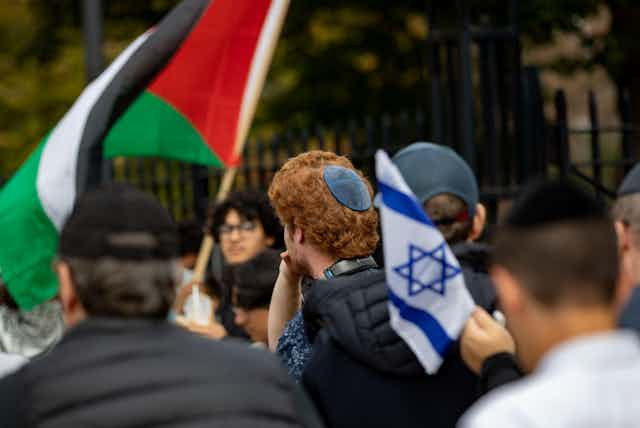University campuses have long been hubs of political activism. As young people form their own opinions away from their parents, many act passionately for causes they believe in. This includes the situation in Israel and Palestine, a regular feature of student debate in the US, UK and across Europe for decades.
This latest, brutal round of fighting between Israel and Hamas has heightened campus tensions dramatically.
Jewish students have said they fear for their safety due to incidents of antisemitism on campus. Others have reported feeling let down by university leadership for vague statements about the conflict. The UK’s education minister, Gillian Keegan, has written to university vice-chancellors in England about concern for the welfare of Jewish students.
Palestinian students have also expressed concerns about restrictions on their speech when it comes to supporting Palestinian liberation. Students at SOAS University of London were temporarily suspended following a Gaza solidarity rally. While SOAS said the suspension was due to the students’ conduct during the rally and not the rally’s message, the SOAS Palestine Society declared this a “targeting act of political repression”.
University leadership often struggles to balance student safety and free speech on such a polarising issue, leading to inflammatory headlines. But this should not be a reason to dismiss campus debate. Students and young people have always been important in shaping the conversation on Israel and Palestine.
The history of youth activism on Israel-Palestine
Associations of Jewish youth in Europe and the US moved with the first major wave of Jewish immigration between 1881 and 1903 to the British Mandate of Palestine, to work the land and build a Jewish state. Later, the first Palestinian intifada in 1987, a largely nonviolent uprising, was mainly formed of children and teenagers.
I have researched the rise of Israeli-Jewish anti-occupation activism over the last two decades. Until the turn of the millennium, liberal Zionist groups in Israel were the largest and most vocal element of the Israeli peace movement. They called for a two-state solution for the security of Israel.
A turning point came in 2000 as these groups lost traction, unsure how to respond to the increasingly violent Al-Aqsa intifada. In their place emerged more radical groups, drawing on Palestinian narratives of anti-occupation, apartheid and settler colonialism.
Driven by younger Israeli activists, this more radical faction included groups such as Anarchists Against the Wall, a direct action group formed in Israel in 2003. Their members – including students and university lecturers – joined Palestinian activists in resisting the separation barrier dividing the West Bank from Israel.

This radical faction’s numbers have never been more than a few hundred. They are marginalised by Israeli society and subjected to police and army violence. But they have had a notable influence in normalising anti-occupation sentiment within the peace movement in Israel.
In 2009, Israeli activists initiated sit-ins and demonstrations with Palestinians who were threatened with eviction from their homes in the East Jerusalem neighbourhood of Sheikh Jarrah. Some of these activists were students at the Hebrew University of Jerusalem, a short bus ride from the neighbourhood.
Young Jews in the UK have also taken more progressive views on Israel and Palestine. A recent report by the Institute for Jewish Policy Research found that more secular, younger, university-educated respondents were more likely to be critical towards Israel than older, more religious or non-university educated Jews.
The anti-occupation voice of the younger generation is evident in the emergence of progressive Jewish groups such as Yachad, formed in 2011, and Na'amod in 2018.
Students and radical activism
Professor Hank Johnston, a leading scholar of social and political movements, explains that younger members of social movements are often more militant and passionate in their demands and tactics. This is true regardless of their ideological underpinnings.
Young activists are willing to take greater risks for the cause they are supporting. They may not have the material resources of the older generations, but they have more disposable time, energy and ability to mobilise others.
As I argue in my book on the changing Israeli peace movement, it is often the more radical groups who mobilise quicker in periods of tension. In doing so, they set the agenda, influencing moderate groups to take up more confrontational ideas.
For example, members of the Israeli Council for Israeli-Palestinian Peace held illegal meetings with members of the Palestinian Liberation Organisation in the 1980s. These activists called for negotiations with Palestinians long before liberal Zionist groups mobilised under the banner of a two-state solution.
Since the second intifada (2000-2005), more radical Israeli groups framed the situation in Israel and Palestine as apartheid. Only years later did other Israeli human rights groups, such as B'Tselem, officially follow suit.
These radical groups and viewpoints, in part driven by young people, have influenced the narratives in Israel. They are why campus tensions around the conflict are important to pay attention to. The historic significance of young voices suggest they could shape the agenda for the future.
Read more: Israel-Hamas war: updates on The Conversation's coverage of the conflict

